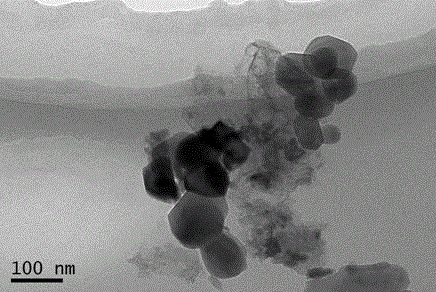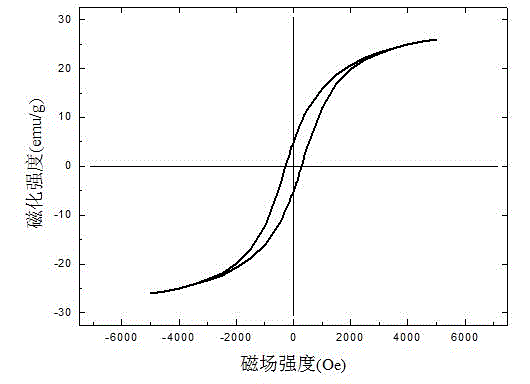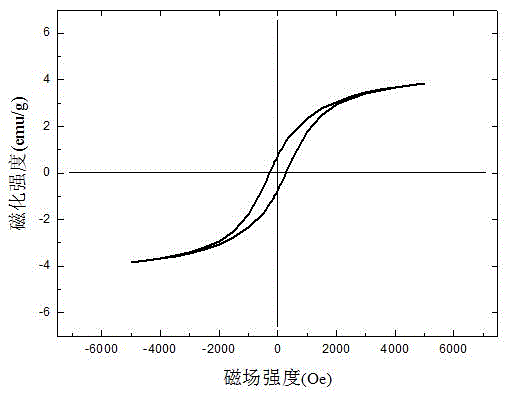Nano chromium carbide ferrofluid and preparation method thereof
A nano-chromium carbide and chromium carbide technology, applied in chemical instruments and methods, carbon compounds, nanotechnology, etc., can solve the problems of ferromagnetism that cannot be eliminated, magnetic fluid instability, and magnetic performance degradation
- Summary
- Abstract
- Description
- Claims
- Application Information
AI Technical Summary
Problems solved by technology
Method used
Image
Examples
Embodiment 1
[0024] Weigh 30 g of chromium nitrate nonahydrate and 4 g of anhydrous glucose, dissolve them in deionized water at 80 ° C, and mix the raw materials thoroughly with electric stirring, then prepare the precursor required for carbonization by spray drying. Put the precursor powder into a tube-type atmosphere furnace, pass in hydrogen for carbonization, hold at 550°C for 1 hour, then rise to the carbonization temperature of 1200°C, the heating rate is 10°C / min, and the carbonization holding time is 3 hours. The chromium carbide particles prepared after carbonization were high-energy ball milled in a stainless steel ball mill tank for 6 hours, the ball-to-material ratio was 10:1, and the speed was 400r / min. Using the sedimentation effect of a strong magnetic field, the nano-magnetic chromium carbide particles are repeatedly washed with secondary deionized water and absolute ethanol to remove residual carbon and other non-magnetic impurities, and then added to a certain proportion ...
Embodiment 2
[0026] Weigh 40 g of chromium nitrate nonahydrate and 7 g of anhydrous glucose, dissolve them in deionized water at 80 ° C, and mix the raw materials thoroughly with electric stirring, then prepare the precursor required for carbonization by spray drying. Put the precursor powder into a tube-type atmosphere furnace, pass in hydrogen for carbonization, hold at 550°C for 1 hour, then rise to the carbonization temperature of 1100°C, the heating rate is 8°C / min, and the carbonization holding time is 4 hours. The chromium carbide particles prepared after carbonization were high-energy ball milled in a stainless steel ball mill tank for 7 hours, the ball-to-material ratio was 10:1, and the speed was 400r / min. Using the sedimentation effect of a strong magnetic field, the nano-magnetic chromium carbide particles are repeatedly washed with secondary deionized water and absolute ethanol to remove residual carbon and other non-magnetic impurities, and then added to a certain proportion o...
Embodiment 3
[0028]Weigh 50g of chromium nitrate nonahydrate and 5g of anhydrous glucose, dissolve them in deionized water at 80°C, and mix the raw materials thoroughly with electric stirring, then prepare the precursor required for carbonization by spray drying. Put the precursor powder into a tube-type atmosphere furnace, pass in hydrogen for carbonization, hold at 550°C for 1 hour, and then rise to the carbonization temperature of 1300°C, the heating rate is 10°C / min, and the carbonization holding time is 2.5 hours. The chromium carbide particles prepared after carbonization were high-energy ball milled in a stainless steel ball mill tank for 8 hours, the ball-to-material ratio was 10:1, and the speed was 400r / min. Using the sedimentation effect of a strong magnetic field, the nano-magnetic chromium carbide particles are repeatedly washed with secondary deionized water and absolute ethanol to remove residual carbon and other non-magnetic impurities, and then added to a certain proportion...
PUM
| Property | Measurement | Unit |
|---|---|---|
| Saturation magnetization | aaaaa | aaaaa |
Abstract
Description
Claims
Application Information
 Login to View More
Login to View More - R&D
- Intellectual Property
- Life Sciences
- Materials
- Tech Scout
- Unparalleled Data Quality
- Higher Quality Content
- 60% Fewer Hallucinations
Browse by: Latest US Patents, China's latest patents, Technical Efficacy Thesaurus, Application Domain, Technology Topic, Popular Technical Reports.
© 2025 PatSnap. All rights reserved.Legal|Privacy policy|Modern Slavery Act Transparency Statement|Sitemap|About US| Contact US: help@patsnap.com



